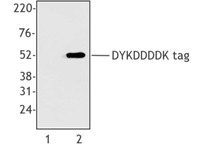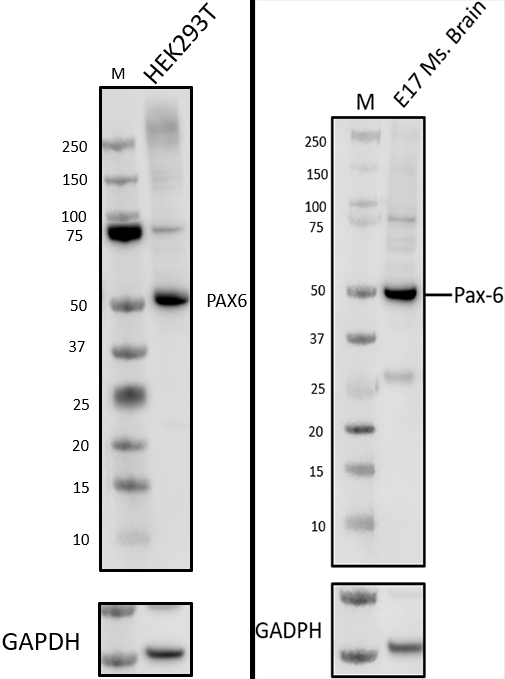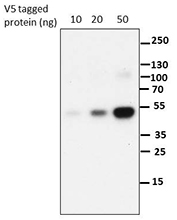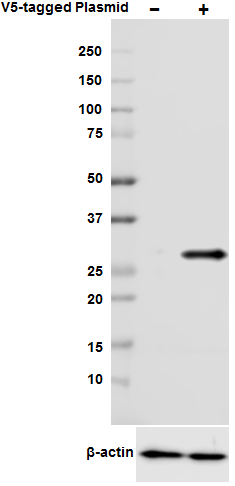- Clone
- Poly6308 (See other available formats)
- Regulatory Status
- RUO
- Other Names
- SRY (sex determining region Y)-box 2, ANOP3, SOX-2
- Isotype
- Rabbit Polyclonal IgG
- Ave. Rating
- Submit a Review
- Product Citations
- publications

-

Total lysates (15 µg protein) from NTERA-2 and HeLa were resolved by electrophoresis (4-12% Bis-Tris gel), transferred to nitrocellulose, and probed with 1:500 purified anti-SOX2 antibody, clone Poly6308. Proteins were visualized using chemiluminescence detection by incubation with HRP anti-Rabbit secondary antibody (Cat. No. 410406, 1:3000 dilution). Direct-Blot™ HRP anti-β-actin antibody was used as a loading control (Cat. No. 664804, 1:25,000 dilution).
| Cat # | Size | Price | Quantity Check Availability | Save | ||
|---|---|---|---|---|---|---|
| 630801 | 50 µL | £101 | ||||
| 630802 | 200 µL | £221 | ||||
This rabbit polyclonal antibody recognizes human SOX2 also known as SRY (sex determining region Y)-box 2 and ANOP3. SOX2 is a nucleus protein, predicted molecular weight 34 kD. SOX2 belongs to the SOX (SRY-box containing gene) gene family which encodes a group of transcription factors defined by the conserved high motility group (HMG) DNA-binding domain. They are involved in the regulation of embryonic development and in the determination of cell fate. Defects in SOX2 are a cause of true or primary anophthalmos, also called anophthalmia or ANOP3. Anophthalmos is a developmental defect characterized by complete absence of the eyes (rare) or by the presence of vestigial eyes. The poly6308 antibody has been shown to be useful for Western blotting.
Product DetailsProduct Details
- Verified Reactivity
- Human
- Antibody Type
- Polyclonal
- Host Species
- Rabbit
- Immunogen
- Peptide-KLH (N-terminal)
- Formulation
- This antibody is provided in phosphate-buffered solution, pH 7.2, containing 0.09% sodium azide and 50% glycerol.
- Preparation
- The antibody was purified by antigen-affinity chromatography.
- Concentration
- Lot-specific (to obtain lot-specific concentration and expiration, please enter the lot number in our Certificate of Analysis online tool.)
- Storage & Handling
- Upon receipt, store frozen at -20°C.
- Application
-
WB
- Recommended Usage
-
Each lot of this antibody is quality control tested by Western blotting. Western blotting, suggested working dilution(s): Use 10 µl per 5 ml antibody dilution buffer for each minigel. It is recommended that the reagent be titrated for optimal performance for each application.
- Application Notes
-
This product may contain other non-IgG subtypes.
- Product Citations
-
- RRID
-
AB_2195784 (BioLegend Cat. No. 630801)
AB_2195784 (BioLegend Cat. No. 630802)
Antigen Details
- Structure
- Belongs to the SOX (SRY-box containing gene) gene family, predicted molecular weight 34 kD.
- Distribution
-
Nucleus protein
- Function
- The SOX gene family encodes a group of transcription factors defined by the conserved high motility group (HMG) DNA-binding domain. They are involved in the regulation of embryonic development and in the determination of cell fate.
- Interaction
- Interacts with OCT4, OCT1, FTZ1, and Fibroblast growth factor 4 proteins.
- Cell Type
- Embryonic Stem Cells, Mesenchymal Stem Cells, Neural Stem Cells
- Biology Area
- Cell Biology, Immunology, Neuroscience, Neuroscience Cell Markers, Stem Cells, Transcription Factors
- Antigen References
-
1. Stevanovic M, et al. 1994. Mammalian Genome 5:640.
2. Okubo T, et al. 2006. Genes Dev. 20:2654.
3. Ragge NK, et al. 2005. Am. J. Med. Genet. 135A:1. - Gene ID
- 6657 View all products for this Gene ID
- UniProt
- View information about SOX2 on UniProt.org
Related FAQs
Other Formats
View All SOX2 Reagents Request Custom Conjugation| Description | Clone | Applications |
|---|---|---|
| Purified anti-SOX2 (NH2 terminus) | Poly6308 | WB |
Customers Also Purchased



Compare Data Across All Formats
This data display is provided for general comparisons between formats.
Your actual data may vary due to variations in samples, target cells, instruments and their settings, staining conditions, and other factors.
If you need assistance with selecting the best format contact our expert technical support team.
-
Purified anti-SOX2 (NH2 terminus)

Total lysates (15 µg protein) from NTERA-2 and HeLa were res...
 Login / Register
Login / Register 








Follow Us